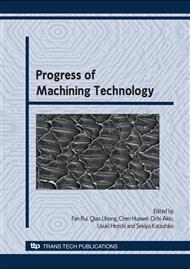p.24
p.28
p.33
p.37
p.41
p.45
p.49
p.53
p.59
Research on Fabricating CVD Diamond Microstructures Using RIE Process
Abstract:
Diamond is one of the most important engineering materials for its extreme hardness, high thermal conductivity value and chemical inertness. Due to its high hardness and strength, it can be ideal candidates for AFM probe or micro-needle. In this research, micro cone-like shaped diamond tips with high aspect ratio formed using reactive ion etching (RIE) method. The scanning electron microscope (SEM), transmission electron microscope (TEM) and micro-Raman spectroscopy were used to study the surface morphology and sub-surface micro-structure before and after RIE process. The results showed that gold could be adopted as mask material during the RIE process. Different microstructures could be obtained using different RIE parameters such as etch duration and reactant gas. After RIE (O2 50sccm, 200W) for 5min the micro cone-like structures (aspect ratio~8) could be observed on the surface if a thin layer of gold was applied as mask. However, under the same RIE conditions, the irregular pillar-like microstructures started to emerge if the etching time was stretched longer.
Info:
Periodical:
Pages:
41-44
Citation:
Online since:
February 2009
Authors:
Keywords:
Price:
Сopyright:
© 2009 Trans Tech Publications Ltd. All Rights Reserved
Share:
Citation:


